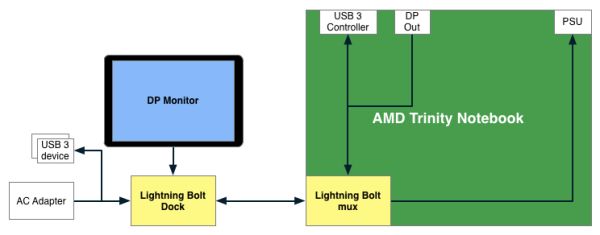Demonstrated behind closed doors, AMD unveiled its answer to Intel's Thunderbolt interface, the 'Lightning Bolt'.
Developed alongside Apple, Intel's Thunderbolt interface allows for a Thunderbolt cable, sporting a Mini DisplayPort connector, to carry both the DisplayPort 1.2 and PCI Express protocols simultaneously over two full-duplex 10Gbps lanes, along with a 10W power supply. Pushed onto the market by Apple, the interface can supply power and a super high-speed connection to Thunderbolt peripherals or hubs, optionally reverting to supplying a standard DisplayPort 1.2 signal for DisplayPort devices.
The multi-purpose interface has been all the rage, not only for its exceptionally high performance but also for reducing the number of ports, cables and separate I/O chips required for devices. Until now AMD has been left out in the cold, however its new Lightning Bolt interface hopes to change the firm's interface fortunes.

Like Thunderbolt, Lightning Bolt utilises a Mini DisplayPort connector and is capable of transmitting the DisplayPort protocol, however, instead of passing along a PCI Express signal, AMD has opted to support USB 3.0. The design is not perfect, USB 3.0 is half the speed of Thunderbolt at 5Gbps and AMD claims that whilst certainly faster than USB 2.0, Lightning Bolt will not be capable of reaching the full 5Gbps; likewise, the new interface can only support two monitors at 1080p. On the other-hand, almost no devices exist to fully exploit a 10Gbps connection at this stage in the game and thus far, USB 3.0 as a peripheral protocol has received the most adoption, amongst a wider range of manufacturers.
Lightning Bolt will also feature a power supply, though AMD is yet to release maximum ratings figures, with the firm claiming that all-together, only two pins required changing from a standard DisplayPort cable to make the new interface possible. The real advantage to AMD's approach is cost, with the firm suggesting that a muxing I/O chip for a notebook or similar device would likely amount to $1 and that a dock to demux the signal would be around the same cost as a typical USB 3.0 hub. The protocol is not yet finalised and so performance and specifications may change; this also means that the technology won't be ready for the launch of Trinity during the summer, however AMD does hope to have it on the market before the year is out.














